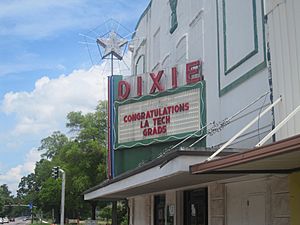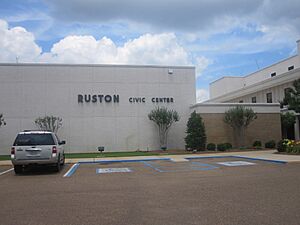Ruston, Louisiana facts for kids
Quick facts for kids
Ruston
Ville de Ruston de Louisiane
|
|
|---|---|
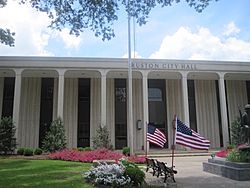
Ruston City Hall
|
|
| Nickname(s):
Louisiana's College Town; The Peach City; Rus Vegas
|
|
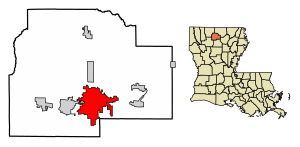
Location of Ruston in Lincoln Parish, Louisiana.
|
|
| Country | |
| State | |
| Parish | Lincoln |
| Incorporated | 1885 |
| Named for | Robert Edwin Russ |
| Government | |
| • Type | Mayor-Council |
| Area | |
| • Total | 21.26 sq mi (55.05 km2) |
| • Land | 21.19 sq mi (54.88 km2) |
| • Water | 0.07 sq mi (0.18 km2) |
| Elevation | 331 ft (101 m) |
| Population
(2020)
|
|
| • Total | 22,166 |
| • Density | 1,046.16/sq mi (403.92/km2) |
| • μSA (2016) | 47,745 (US: 229th) |
| • CSA (2016) | 253,286 (US: 117th) |
| Demonym(s) | Rustonian, Rustonite |
| Time zone | UTC-6 (CST) |
| • Summer (DST) | UTC-5 (CDT) |
| ZIP code |
71270, 71272, 71273
|
| Area code(s) | 318 |
| Interstate | |
| U.S. | |
| Louisiana | |
| Airport | Ruston Regional Airport |
Ruston is a city in Lincoln Parish, Louisiana, United States. It is the main city of the Ruston micropolitan statistical area. This area includes all of Lincoln Parish. Ruston is also home to Louisiana Tech University. In 2020, about 22,166 people lived there.
Contents
History of Ruston
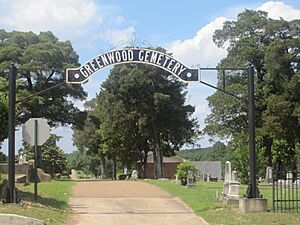
After the American Civil War, a railroad was planned to cross northern Louisiana. This railroad would connect the southern states with the western parts of the country. Robert Edwin Russ, who was the sheriff of Lincoln Parish, gave 640 acres (about 2.6 square kilometers) of his land for the new town. This area later became known as Ruston, which is a shorter way of saying "Russ town."
In 1883, land lots for homes and businesses were sold. Soon, the sounds of building and sawing wood filled the air. New churches, businesses, and schools were built. The economy grew thanks to cotton farming.
In 1900, a second railroad was built through Ruston, running north and south. This brought even more businesses and jobs to the area. By the time the U.S. joined World War I in 1917, Ruston was a strong center for learning and business.
Ruston continued to grow after World War II. Many war veterans went to college using the GI Bill of Rights. This helped the local economy and led to growth at Louisiana Tech University and nearby Grambling State University. New families moved to Lincoln Parish. In the mid-1960s, Interstate 20 was built through the northern part of Ruston. This highway made it easier to travel to and from Ruston, just like the railroad had done earlier.
Even when the state's oil industry faced problems in the 1980s, Ruston kept growing. This was because Louisiana Tech University was expanding quickly. The city also celebrated its 100th birthday during this time. Efforts were made to make the historic downtown area beautiful again. Many buildings in Ruston are now listed on the National Register of Historic Places.
Today, Ruston has a new airport for businesses. The timber, poultry, and cattle industries continue to grow in the area.
Geography of Ruston
Ruston is located at 32°31′47″N 92°38′26″W. It is about 331 feet (101 meters) above sea level.
The city covers a total area of about 18.2 square miles (47.1 square kilometers). Most of this area, about 18.1 square miles (46.9 square kilometers), is land. A small part, about 0.1 square miles (0.26 square kilometers), is water.
Population and People
| Historical population | |||
|---|---|---|---|
| Census | Pop. | %± | |
| 1890 | 767 | — | |
| 1900 | 1,324 | 72.6% | |
| 1910 | 3,377 | 155.1% | |
| 1920 | 3,389 | 0.4% | |
| 1930 | 4,400 | 29.8% | |
| 1940 | 7,107 | 61.5% | |
| 1950 | 10,372 | 45.9% | |
| 1960 | 13,991 | 34.9% | |
| 1970 | 17,365 | 24.1% | |
| 1980 | 20,585 | 18.5% | |
| 1990 | 20,027 | −2.7% | |
| 2000 | 20,546 | 2.6% | |
| 2010 | 21,859 | 6.4% | |
| 2020 | 22,166 | 1.4% | |
| U.S. Decennial Census | |||
Ruston has grown steadily over the years. In 1890, there were 767 people. By 2020, the population had grown to 22,166 people.
| Race | Number | Percentage |
|---|---|---|
| White (non-Hispanic) | 11,201 | 50.53% |
| Black or African American (non-Hispanic) | 8,867 | 40.0% |
| Native American | 86 | 0.39% |
| Asian | 551 | 2.49% |
| Pacific Islander | 5 | 0.02% |
| Other/Mixed | 693 | 3.13% |
| Hispanic or Latino | 763 | 3.44% |
In 2020, there were 22,166 people living in Ruston. The city had 7,970 households. About half of the people were White (non-Hispanic), and 40% were Black or African American.
Arts and Culture in Ruston
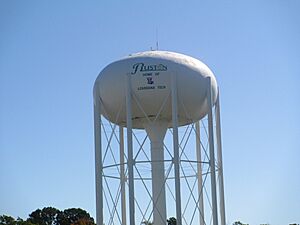
Many cultural activities in Ruston are offered through Louisiana Tech University. There are also shops downtown and several restaurants. The city has an eight-screen movie theater called Celebrity Theater. You can also find more cultural opportunities in nearby Grambling and Monroe. The Louisiana Tech University Arboretum is a popular place to visit.
In 2007, the city started a plan called "Ruston 21" to help the area grow. This plan looks at how to improve homes, parks, transportation, and the economy. It also focuses on working with Louisiana Tech University.
The historic Dixie Theater opened in 1928. It is a main spot for visual and performing arts in Ruston. It hosts plays, art shows, movies, dance shows, and music concerts. Celebrity Theatres, a modern movie theater, opened in Ruston in 2006. Louisiana Tech also has its own places for performing arts and art galleries.
The Louisiana Military Museum shows uniforms, weapons, and vehicles from many U.S. conflicts. The Kidd-Davis house, built in 1886, is now the Lincoln Parish Museum. It shows the early history of Ruston. The Idea Place Math and Science Discovery Center at Louisiana Tech has fun science exhibits and a planetarium.
Ruston is in a part of Louisiana known for outdoor activities like hunting and fishing. Garland Gregory Hideaway Park on the Louisiana Tech campus has a lake for fishing and canoeing. It also has walking trails and an 18-hole frisbee golf course. The North Louisiana Exhibition Center in Ruston hosts rodeos, horse shows, and antique car shows.
Ruston is a big center for college sports, as it is home to the Louisiana Tech Bulldogs and Lady Techsters. The Louisiana Tech Bulldogs football team plays at Joe Aillet Stadium. They have won many championships. The basketball teams play at the Thomas Assembly Center. The Lady Techsters basketball team is one of the most successful women's college basketball programs ever. The Louisiana Tech Bulldogs baseball team also plays at J. C. Love Field at Pat Patterson Park.
Peach Festival
Every June, Ruston holds its yearly Peach Festival. This festival celebrates the area's peach farming history. The first festival was held in 1951.
The festival includes races, like a 5K and a 1-mile run. There is also a tennis tournament held at Louisiana Tech.
Railroad Fest
Railroad Fest is a yearly festival held in Downtown Ruston every April since 2017. It features local makers, live music, and celebrates the city's culture. The Makers Fair is at the Historic Ruston Fire Station. Live music is performed at the amphitheater in Railroad Park.
Education in Ruston
Schools for Kids
Public schools in Ruston are part of the Lincoln Parish School System. Eight of the twelve schools in Lincoln Parish are in Ruston.
- Lincoln Parish Early Childhood Center: For preschool children.
- Glen View Elementary School and Hillcrest Elementary School: For kindergarten through second grade.
- Cypress Springs Elementary School and Ruston Elementary School: For third through fifth grade.
- I. A. Lewis School: For sixth grade.
- Ruston Junior High School: For seventh and eighth grades.
- Ruston High School: For ninth through twelfth grades.
A. E. Phillips Laboratory School is on Louisiana Tech's campus. It offers kindergarten through eighth grade.
Ruston also has several private schools:
- Cedar Creek School and Bethel Christian School: Offer preschool through twelfth grade.
- New Living Word School: Offers preschool through twelfth grade.
- Montessori School of Ruston: Offers preschool through eighth grade.
Lorraine Nobles Howard Education Center, or Howard School, is a special school for children living at the Louisiana Methodist Children's Home in Ruston.
Colleges and Universities
Louisiana Tech University is a major university in Ruston. It gives the city its "college town" feel. Grambling State University is also nearby, just four miles west of Louisiana Tech. Additionally, Louisiana Delta Community College has a campus in Ruston.
Media
The Ruston Daily Leader is the local newspaper. It has been serving Ruston and Lincoln Parish since 1894. The Daily Leader is published Sunday morning and Monday through Friday afternoons. Louisiana Tech University also has its own student newspaper, The Tech Talk.
Radio
Ruston is the main city for the Ruston radio market.
Television
Ruston is part of the Monroe media market for television.
City Services
National Guard
The 527th Engineer Battalion, known as "Triple Alpha," is based in Ruston. This group is part of the 225th Engineer Brigade of the Louisiana National Guard.
Law Enforcement
Ruston has several law enforcement agencies:
- Lincoln Parish Sheriff's Office
- Louisiana State Police
- Ruston Police Department
Notable People from Ruston
Many well-known people have connections to Ruston, including:
- Trace Adkins, country music singer
- Leon Barmore, Hall of Fame NCAA basketball coach
- Terry Bradshaw, Pro Football Hall of Famer
- Kix Brooks, country music singer
- P.J. Brown, retired NBA player
- Mary Elizabeth Talbot Busbee, former First Lady of Georgia
- Fred Dean, NFL Hall of Famer
- Tim Floyd, NCAA and NBA basketball coach
- Ralph Garr, former Major League Baseball player
- Aaron Holiday, NBA player
- Sonja Hogg, founding coach of the Louisiana Tech Lady Techsters
- Bert Jones, former NFL quarterback
- Dub Jones, former NFL halfback
- Karl Malone, Basketball Hall of Famer
- Luke McCown, former NFL quarterback
- Paul Millsap, retired NBA player
- Kim Mulkey, college women's basketball coach
- Patrick Ramsey, former NFL quarterback
- Willie Roaf, NFL Hall of Fame player
- Kramer Robertson, MLB player
- Scotty Robertson, basketball coach
- Josh Scobee, former NFL player
- Mickey Slaughter, former NFL quarterback
- Scotty Thurman, former basketball player
- Kyle Williams, former NFL player
Images for kids
See also
 In Spanish: Ruston (Luisiana) para niños
In Spanish: Ruston (Luisiana) para niños




